By Jan Worth-Nelson
When Kay Schwartz and her crew of 31 staff and the library’s board of trustees began the planning process seven years ago for the Flint Public Library’s major renovation which culminated with a three-day opening celebration May 19-21, one value emerged over all others.
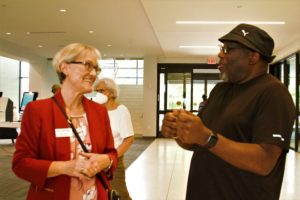
Library patron and Flint resident, Garry McDaniel, chats with Library Director Kay Schwartz. McDaniel remarked the new library looked “beautiful.” “When I walked in I felt like I was in a building in New York City,” said McDaniel.
“We wanted it to be a welcoming community space above everything else,” Schwartz said, walking around the capacious new layout the day before the public opening of the dramatically made-over 60-year-old Kearsley Street structure.
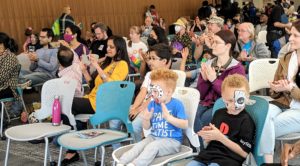
Opening day crowds watch presentations and performances in the new library on Saturday, May 21. (Photo by Paul Rozycki)
“We’re providing space, and people can decide what they want to do with it,” Schwartz said. “We have opportunities for people that they never had, different types of seating, different types of meeting space — we hope they’ll do some exciting things with it.”
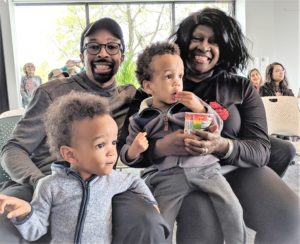
Nathan, Susan, Amir, Ailden watch the “bubbleman” perform a the library’s grand opening. (Photo by Paul Rozycki)
Among many “welcoming” moves, the library added automatic doors and a filtered water system; new seating of different “postures” has been added so that people of any size or shape can find a comfortable place to sit.
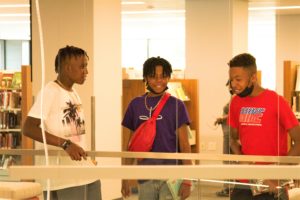
Joseph Baker, 12 (center) and Jayoin Mitchell, 13 (left) stand with a friend looking over the new library. (Photo by Tom Travis)
The staff have added art by local artists, including the new mural by Kevin “Scraps” Burdick visible through huge windows from both of the main floors.

Mary Pace, dental hygiene professor at Mott Community College, and Kay Schwartz. Mary said she “came to hear the Mott Steel Drum Band and felt the new library and the event was truly impressive.” (Photo by Paul Rozycki)
To facilitate family uses, every restroom has a changing table. The children’s section has been expanded, a first-time storytelling room has been added, with a “child scale” restroom attached. There is even a snack area now — a big departure for library management.

Nicole Strickland (left) and Anyah Coleman check out the fish in the fish tank in the Children’s department of the new library. (Photo by Tom Travis)
From the start, all these changes and more fell to the project’s architects, OPN of Cedar Rapids IA, to listen and to translate that value into brick and mortar that would communicate openness, accessibility, and even pleasure.
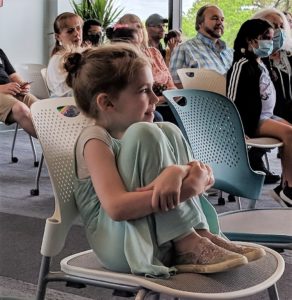
Claire Marshall was entranced with the Bubbleman show and said that her favorite was “When he made a bubble bear”. (Photo by Paul Rozycki)
The result, according to Toby Olsen, associate principal of OPN and major architectural domo of the Flint project, reflects a commitment to democracy and love.
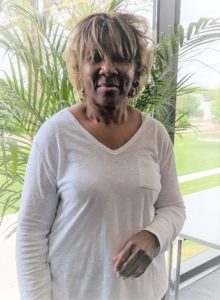
Maryanne Dobson, toured the library and felt” they did a great job with the project.”
That philosophy is most evident in the library’s exhilarating use of light — both a physical joy to move around in and a metaphor for a public library’s role.
“One of our big goals was to open [the space] up. There are so many windows, and we made even more, adding especially to the east side of the building,” Schwartz noted.
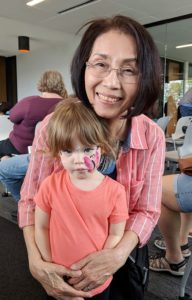
Kazuko and Aya Orhima were busy watching the “Bubbleman program” in the Harris Room and “were very impressed with both the Bubbleman and the new library”.
And in addition, library designers lowered the bookshelves so people can see over them, making spaces feel bigger and airier. They have added “face forward” shelving so that patrons can see the cover of a book as they browse.
“Where ever there is a window, there is either a meeting room, or seating. The designers pulled the collections in away from the windows, to give the windows to the public,” Schwartz said.
Olsen said he and his team strongly connected with the FPL’s aims, both philosophically and architecturally. It’s a specialty of the company: OPN has designed more than 40 libraries across the country.
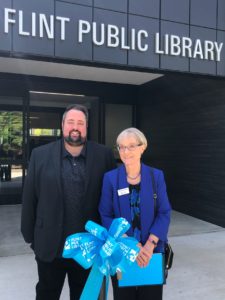
Toby Olsen, associate principal of OPN and FPL Director Kay Schwartz. (Photo by Jan Worth-Nelson)
Working on a library is “a project we love,” Olsen said after the ribbon cutting, surveying the shiny new look he had played a major role in.
“A library is one of the most democratizing of all spaces,” he said. “Libraries are some of the last few spaces where you can go where there’s no expectation to spend money.”
In a library, “Whoever walks through the doors is treated the same way, and that is truly amazing.” Olsen said.
“Those ethics go hand in hand with the mission of libraries that intrigue us, and then you pepper in the community gathering aspect, the ability to have discussions freely and openly — it’s worthy of thinking and hard work.

Libraries are safeguards to democracy, he said, “safeguards to making sure we aren’t devoid of free thinking, free thought. In a library we make sure we have access to materials, and you can come and immerse yourself.
“We firmly believe libraries are the greatest act of love you can give your community They’re a space where everybody is welcome, no matter your station, creed, or aspect of your life.”
“Love and democracy need to be together,” he said.
Olsen said the Flint project was “incredibly unique” in part because it was pre-pandemic when it started — and also one of the largest renovations OPN has done for an existing library.
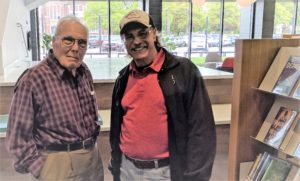
Bill Baker and Tracy Krumm took in the whole library and Tracy was impressed most with the “open spaces and well lighted areas of the new library.” (Photo by Paul Rozycki)
“It’s a big building, and it was amazing that we were able to make it ‘like new’ in every square inch of the interior,” he said.
The swathes of windows accomplish many key elements.
“Especially with institutions funded with public dollars, there is a a metaphoric and symbolic reason for windows — that’s inherent in [the design]. Making the building transparent allows people to see what’s going on.
“It’s like like advertising what’s going on inside a jewel box,” he said. “Even if you’re not a frequent visitor to the library, you will be able to go by and see what it is. You know it’s not a school, not an office building, not an apartment building.”
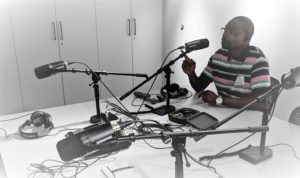
Michael Clack was a volunteer in the Media Room where he showed how one could produce podcasts from the library. (Photo by Paul Rozycki)
At night, he predicts, the building “becomes a jewel box that glows, highlighting the collection inside and the people in there.”
The design shows off what happens in a library.
“Libraries aren’t just a warehouse for books, they are like a multi-pronged Swiss army knife that enables so many things,” he said.
And course, he noted, there’s the connection between light and knowledge — and a library being “a beacon and a place of hope.” The library sets patrons off on a journey — from cradle to grave, with something to be discovered and learned at any age, he said.

Rasheeda Mitchell (right) came with her family to look over the new library. (Photo by Tom Travis)
Olsen, who came to Flint almost monthly over the past several years, said he and his Flint team of five respected and loved the city from the start, never seeing it in the light of its sometime notoriety in the outside world.
They have stayed in local hotels and eaten in local restaurants, Cork on Saginaw and the new Sauce at the Hilton Gardens among their favorites.
And the Cultural Center, including the library, is “incredibly unique” for a city the size of Flint: many U.S. cities have nothing comparable, he observed. Architecturally, this added an additional plus to the library design — the building has “parks” on two sides.
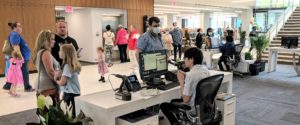
Entrance lobby and circulation desk of the new library. (Photo by Paul Rozycki)
“This is a community where people care, ” Olsen said. “Yes, they’ve been through hell and high water, but this is still a place where good things happen, and good people deserve good things.”
Olsen and his OPN team are wrapping things up at the library, taking care of a few odds and ends. “It’s bittersweet for us because we’ve been so close to it but …now it belongs in the hands of the public. This is the part where it’s time for the library to be gifted to the people who deserve it most.
Sweeping his gaze over the library one more time, he said, “This is totally citizen goodness happening.”
As of May 21, the official opening day, the library, at 1026 E. Kearsley St., will be open five days a week: Tuesday, Wednesday and Thursday 11 a.m. to 8 p.m. and Friday and Saturday 9 a.m. to 6 p.m. More information is available at 810-249-2038, www.fpl.info.
Banner photo: Mural by Kevin “Scraps” Burdick, new and visible from both floors of the new library.
EVM Consulting Editor Jan Worth-Nelson can be reached at janworth1118@gmail.com.

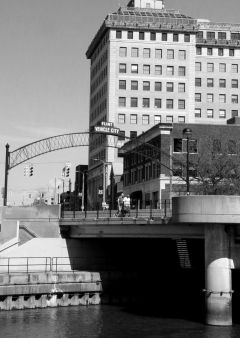
You must be logged in to post a comment.